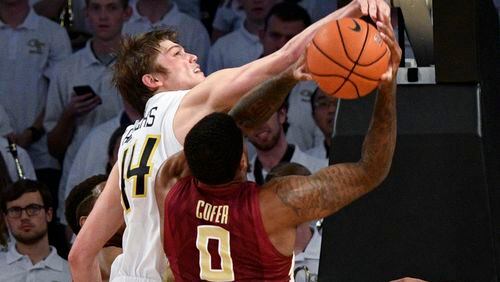Within the first five possessions of Georgia Tech’s upset of No. 6 Florida State on Wednesday, the Yellow Jackets had shown the Seminoles a man-to-man defense, a 2-3 zone and a 1-3-1 zone. They applied a half-court trap and used guard Corey Heyward to pressure full court.
The various looks, executed with effort and precision, set the stage for one of the more unlikely results of the ACC season, a near shutdown of Florida State’s highly efficient offense that scored but 15 points in the first half. Tech’s offensive numbers were, by most standards, decent, but it was the defense that drove the 78-56 rout.
“I think we had the highest field-goal shooting percentage in the ACC, and we look up, we shoot 17 percent in the first half,” FSU coach Leonard Hamilton said. “And I think that’s to their credit. I know we had some point-blank layups and some open looks that we normally make, but I think that their mixing defenses up, I thought, made our kids a little tentative.”
FSU was only the latest team to get its offense scrambled by the Jackets. Tech has surged to 12-8 overall and 4-4 in the ACC, a stunning development for a team expected to win three or four games in the entire conference schedule, on the strength of its defensive play. Tech goes into Saturday’s game against No. 14 Notre Dame leading the ACC in field-goal percentage defense for conference games, at 39.6 percent.
Tech hasn’t compiled that rate on the backs of ham-handed bunglers. Tech’s eight ACC opponents thus far include the top six teams in field-goal percentage. All but one was held under its season field-goal percentage.
The Jackets’ predilection for shifting defenses from possession to possession has been a hallmark. Against Virginia, Cavaliers coach Tony Bennett said Tech threw a box-and-one, a matchup zone, a 1-3-1 and man-to-man defense at the Cavaliers. The Cavaliers won 62-49, but shot 45.8 percent, their second-lowest rate against an ACC opponent thus far.
The intent of mixing defenses is to keep opponents off balance and force them to spend time at the start of the possession getting a gauge on what defense Tech is playing, burning precious seconds off the shot clock.
Coming out of timeouts, center Ben Lammers said, the team often won’t configure in its zone alignment until the opposition inbounds the ball so as to keep the guessing game going.
Tech plays a 2-3 zone that is more intricate than divvying up sections of the court among the five players. Teammates read the ball, the opponent and one another to rotate or drop down to cover for one another.
“It takes a little while to get used to, but there’s times when, if everyone’s doing their job right, it’s very hard to do anything against,” Lammers said.
The philosophy of coach Josh Pastner’s defense is to shrink the court, or make opponents with the ball uncomfortable. After made baskets, Tech will sometimes challenge full court. In the half court, defenders will pressure the ball out near the midcourt logo.
If the ball goes in the lane, it’s not uncommon for four or five players retreat into the paint. On FSU’s third possession Wednesday, guard Terrance Mann received the ball under the basket in a hole in the 2-3 zone. By the time he took a dribble and pump faked against Lammers, four players had at least one foot in the zone. Forward Quinton Stephens blocked Mann from behind to kill the possession. Tech leads the ACC in blocks at 6.5 per game.
“If it goes in there, we want to kind of make guys have to make plays and pass it out, not just let them be comfortable in there,” guard Josh Heath said.
The schemes have been infused with the effort that Pastner has demanded. On Florida State’s sixth possession, forward Jarquez Smith took an entry pass in the post. Heath dropped down and poked out the ball when Smith took a loose dribble. Lammers, Stephens and guard Josh Okogie all got on the floor to try to win the loose ball, earning possession with a held ball.
“But I don’t care what defense or offense (you run), if you don’t play hard, if you don’t play with energy, if you’re not flying on the floor and diving on balls and jumping in the stands when the ball’s a loose ball or first to the floor, it doesn’t matter what defense or offense you’re running, you don’t have any chance to win,” Pastner said.
Tech’s defense will have another bear of a test Saturday at McCamish Pavilion. Notre Dame’s offense, a collection of deadly shooters spacing the floor, was ranked the 13th most efficient nationally by kenpom.com going into Friday’s games. Coach Mike Brey’s offense is fluid and unpredictable, which might make for a compelling matchup with Tech’s defense.
“It’s fun to mix it up, keep people on their toes,” Lammers said.
About the Author







